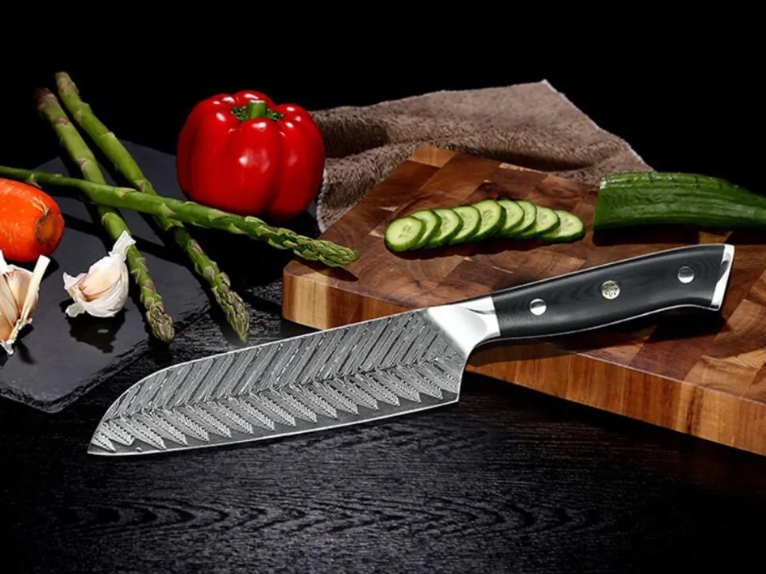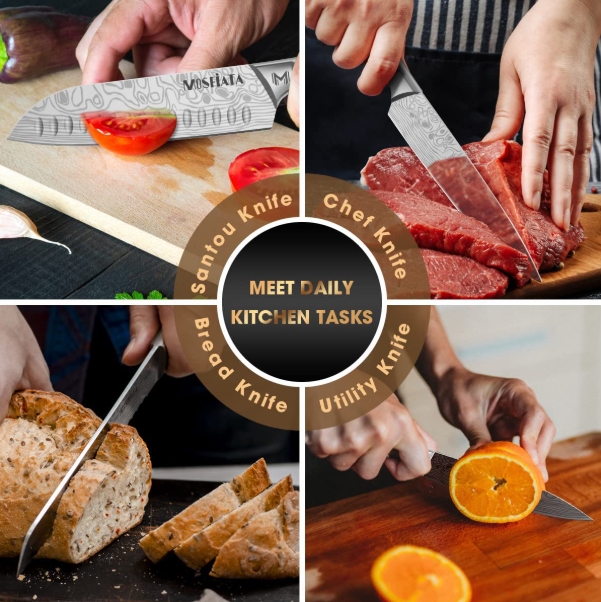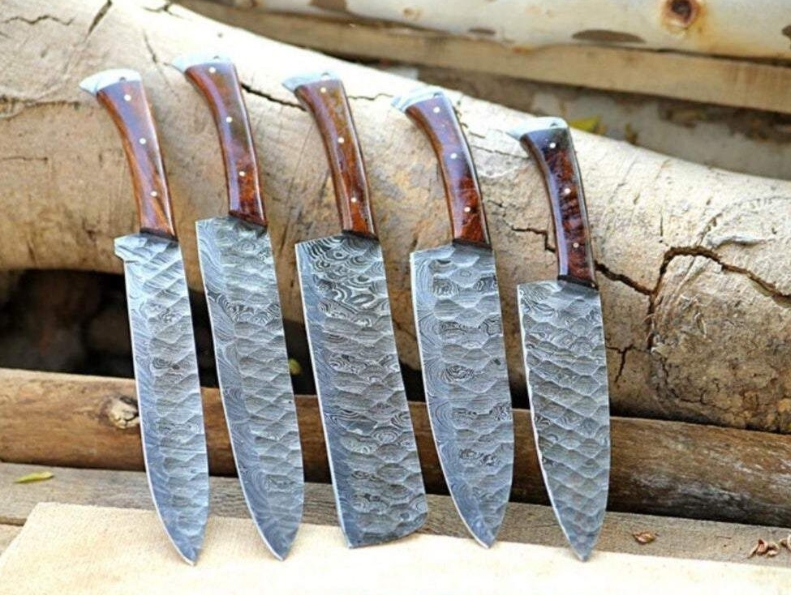

Views: 222 Author: Ella Publish Time: 2025-05-01 Origin: Site








Content Menu
● Why the Right Knife Set Matters in a Restaurant Kitchen
● Essential Knives for Every Restaurant Kitchen
>> Chef's Knife
>> Paring Knife
>> Bread Knife
>> Boning Knife
● Key Factors to Consider When Choosing a Knife Set
>> Sharpness
>> Durability
● Knife Set Recommendations for Restaurant Kitchens
● Knife Maintenance: Keeping Your Set in Top Condition
>> Cleaning
● Safety Tips for Using Knives in a Restaurant Kitchen
● The Importance of Training Your Staff
● Customizing Your Knife Set to Your Restaurant's Needs
● Sustainability and Environmental Considerations
● Frequently Asked Questions (FAQ)
>> 1. What are the most essential knives for a restaurant kitchen?
>> 2. How do I choose the right blade material?
>> 3. What's the difference between forged and stamped knives?
>> 4. How often should restaurant knives be sharpened?
>> 5. What's the best way to store knives in a restaurant kitchen?
Selecting the right knife set for a restaurant kitchen is a pivotal decision that can shape the efficiency, safety, and overall quality of your culinary operation. In a professional kitchen, knives are not just tools-they are extensions of the chef's hands, playing a crucial role in every stage of food preparation. With the overwhelming variety of knife sets available, it's essential to understand what makes a set suitable for your unique restaurant needs. This comprehensive guide explores every aspect of choosing a knife set, from essential types and materials to maintenance, storage, and beyond.

A well-chosen knife set is foundational for any restaurant kitchen. High-quality knives empower chefs to work faster, more safely, and with greater precision. In contrast, dull or poorly made knives can slow down prep work, lead to inconsistent cuts, and increase the risk of accidents. Moreover, the right knives help reduce food waste, maintain ingredient integrity, and allow chefs to execute their creative vision with confidence. Investing in a professional-grade knife set is an investment in your kitchen's productivity, safety, and reputation.
Every restaurant kitchen, regardless of cuisine, should be equipped with a core set of knives. Each knife serves a specific purpose, ensuring chefs can tackle any ingredient or technique with ease.
The chef's knife is the undisputed workhorse of the kitchen. With its broad, curved blade, it handles chopping, slicing, mincing, and dicing a wide range of ingredients. Its versatility makes it indispensable for everything from breaking down vegetables to portioning meat.
Smaller and more agile than a chef's knife, the paring knife excels at peeling, trimming, and intricate tasks that require precision. It's ideal for preparing garnishes, deveining shrimp, or segmenting citrus fruits.
A bread knife features a long, serrated blade designed to slice through crusty loaves without crushing the soft interior. It's also excellent for cutting delicate produce like tomatoes or cakes with layered textures.
With a thin, flexible blade, the boning knife is perfect for removing bones from meat, poultry, and fish. Its design allows for precise cuts, minimizing waste and preserving the integrity of the protein.
The utility knife bridges the gap between the chef's knife and paring knife. It's great for slicing sandwiches, cutting small fruits, and handling mid-sized tasks that don't require a larger blade.
Depending on your menu, you may also need:
- Fillet Knife: For delicate fish work, offering flexibility and control.
- Cleaver: For breaking down large cuts of meat and bones.
- Santoku Knife: A Japanese all-purpose knife, lighter and shorter than a chef's knife, ideal for chopping, dicing, and mincing.
To make an informed choice, it's important to understand the anatomy of a knife:
- Blade: The cutting part, which can be straight, serrated, or scalloped.
- Edge: The sharpened side of the blade.
- Spine: The top, non-cutting edge of the blade.
- Tip: The pointed end used for delicate or detailed work.
- Bolster: The thick junction between the blade and handle, providing balance and safety.
- Tang: The portion of the blade that extends into the handle, contributing to the knife's strength and balance.
- Handle: The grip, which should be comfortable and secure.

The blade material determines the knife's sharpness, durability, and maintenance requirements.
- High Carbon Stainless Steel: Combines the best qualities of carbon and stainless steel, offering sharpness, edge retention, and corrosion resistance.
- Stainless Steel: Easy to maintain and rust-resistant, but may require more frequent sharpening.
- Carbon Steel: Extremely sharp and holds an edge well, but is prone to rust and requires diligent care.
- Ceramic: Lightweight and razor-sharp, but brittle and susceptible to chipping.
- Forged Knives: Created from a single piece of steel, forged knives are heavier, more balanced, and typically more durable.
- Stamped Knives: Cut from a sheet of steel, stamped knives are lighter and more affordable but may lack the heft and longevity of forged knives.
The handle should fit comfortably in your hand, offering a secure grip even when wet. Materials include wood, plastic, and composite. Ergonomics are crucial to reduce fatigue during long prep sessions.
A well-balanced knife feels stable and easy to control, improving both safety and efficiency. Chefs often prefer knives with some weight, as they require less force to cut through tough ingredients.
- Edge Retention: Knives that hold their edge well reduce the frequency of sharpening.
- Ease of Sharpening: Some steels are easier to hone and sharpen, which is vital in a busy kitchen.
Ensure the set includes all essential knives for your menu. Some sets come with honing steels, kitchen shears, and storage blocks, which can add value and convenience.
A high-quality knife should be razor-sharp out of the box and maintain its edge through heavy use. Sharp knives improve efficiency and reduce the risk of accidents, as less force is needed for clean cuts.
Look for knives from reputable manufacturers known for their craftsmanship and quality control. Durable knives withstand the rigors of professional kitchens and last for years with proper care.
Some premium brands offer lifetime warranties and professional sharpening services, providing additional value and peace of mind.
While many brands offer professional-grade knives, a few consistently stand out:
- Wüsthof Classic Ikon Series: Renowned for their forged high-carbon steel blades, ergonomic handles, and precision edge technology.
- Zwilling Professional S Series: Known for great balance, full tang construction, and a comprehensive selection of essential knives.
- Cangshan Thomas Keller Series: Designed by a Michelin-starred chef, these knives feature advanced powder steel and exceptional edge retention.
- Always hand wash knives and dry them immediately to prevent rust and preserve the handle.
- Avoid dishwashers, as harsh detergents and high heat can damage both blades and handles.
- Use a honing steel regularly to maintain the edge between sharpenings.
- Invest in a quality sharpening stone or professional sharpening service for periodic maintenance.
- Store knives in a dedicated block, magnetic strip, or knife roll to protect the blades and prevent accidents.
- Always cut away from your body and keep your fingers clear of the blade.
- Use a stable, non-slip cutting board to prevent accidents.
- Keep knives sharp-dull knives are more likely to slip and cause injuries.
- Never try to catch a falling knife.
- Store knives properly to avoid accidental cuts when reaching for them.
Even the best knife set is only as effective as the people using it. Proper training ensures that all staff members know how to use, clean, sharpen, and store knives safely. Consider regular training sessions or workshops to reinforce best practices and introduce new team members to your kitchen's standards.
No two restaurants are exactly alike. A sushi bar, a steakhouse, and a vegan café will each have different requirements. Consider the following when customizing your knife set:
- Menu Complexity: More diverse menus may require a wider variety of specialty knives.
- Volume: High-volume kitchens benefit from multiple sets or backup knives to avoid downtime during busy shifts.
- Chef Preferences: Some chefs have strong preferences for certain brands, styles, or handle types. Involving your head chef in the selection process can lead to better satisfaction and performance.
As sustainability becomes increasingly important in the restaurant industry, consider the environmental impact of your knife choices:
- Opt for knives made from recycled or sustainably sourced materials.
- Choose durable knives that reduce the need for frequent replacements.
- Proper maintenance extends the life of your knives, minimizing waste.
While it's tempting to save money with cheaper sets, investing in high-quality knives pays off in the long run. Fewer replacements, better performance, and improved safety make premium knives a wise choice for any serious restaurant. Consider your knife set as a long-term investment in your kitchen's success.
Choosing the right knife set for a restaurant kitchen is a critical investment that affects every aspect of your operation. By focusing on quality, comfort, and the specific needs of your menu, you can equip your chefs with tools that enhance efficiency, safety, and creativity. Remember to consider blade material, construction, handle comfort, and maintenance when making your selection. With the right set, your kitchen will be prepared for any challenge, delivering consistent, high-quality results for years to come.

The core knives every restaurant kitchen should have include a chef's knife, paring knife, bread knife, boning knife, and utility knife. Depending on your menu, you might also need specialty knives like a fillet knife or cleaver.
High carbon stainless steel is generally preferred for its balance of sharpness, durability, and corrosion resistance. Ceramic and standard stainless steel are options, but each has its own pros and cons.
Forged knives are made from a single piece of steel and are heavier, more balanced, and more durable. Stamped knives are lighter and more affordable but may not last as long or offer the same performance.
In a busy kitchen, knives should be honed daily and professionally sharpened every few weeks or as needed, depending on usage and the type of steel.
Knives should be stored in a knife block, on a magnetic strip, or in a knife roll to protect the blades and ensure safety. Avoid tossing knives in drawers, as this can dull the edges and create hazards.